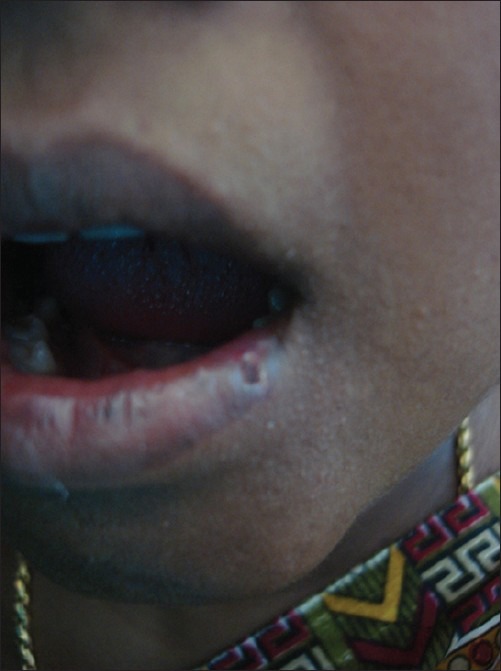Sir,
Sclerotherapy is defined as the targeted elimination of small vessels, varicose veins and vascular anomalies by the injection of a sclerosant.[1] Though sclerotherapy is being used extensively for varicose veins, it's use as a treatment modality for pyogenic granuloma is not commonly reported. Pyogenic granuloma is a common benign vascular proliferation that commonly occurs on the skin. Various treatment options exist with no clear consensus.[2] Pyogenic granulomas have been treated by cryosurgery, curettage, electrodessication, chemical cautery and laser surgery. The therapeutic effects of these conservative treatments are limited and recurrence rates are high.[3] These procedures are accompanied with severe bleeding and are usually messy. We attempted sclerotherapy procedure on pyogenic granuloma because of its vascular nature and the potential response to sclerotherapy in similar other lesions.
We hereby describe the technique of treating pyogenic granuloma by intralesional injection of Sodium tetradecyl sulfate an Egyptian Drug Authority (EDA)- and Food and Drug Administration (FDA) - approved detergent sclerosant. Informed consent was taken and surgical cleaning of the area was done. No local anaesthesia was used during the procedure. The sclerosant used was Sodium tetradecyl sulfate in a concentration of 3 %. A maximum of 0.1 ml of undiluted sclerosant was injected into the lesion with the help of an insulin syringe till the point of blanching. After this, the lesion was compressed with a cotton gauze for 1-2 minutes. There was no bleeding during the procedure. The patient was completely comfortable.
This method was tried in 3 patients with pyogenic granuloma. Two patients were having lesions over the lip (size 1 × 1 cm) [Figure 1] and one patient over the scalp (size 2 × 2 cm). All the three patients had undergone radiofrequency ablation in the past for the same lesions with prompt recurrence of the lesions. After a week, the lesions in all the patients resolved, leaving behind a shallow crater. [Figure 2]. This depression also healed within a week without leaving any residual lesion and scarring [Figure 3]. There was no incidence of any complication after the procedure. There was no recurrence during a three month follow up period.
Figure 1.

Pyogenic granuloma over lip-pre operative photograph
Figure 2.

Post operative photograph at one week-showing a shallow crater
Figure 3.

Completely healed lesion at two weeks
The advantages of this procedure are that it causes minimal discomfort to the patient, negligible blood loss, less cumbersome, minimal surgical expertise is required and above all is economical. There is no requirement of local anaesthesia or post operative dressings or any specific care. The patient can resume his daily activities immediately. We conclude that sclerotherapy with Sodium tetradecyl sulfate 3%, is effective in the treatment of pyogenic granuloma. It offers an alternative to conventional methods like surgery, lasers, radiofrequency ablation and electrodessication and is a simple, safer, feasible and affordable office procedure, which has an enhanced success rate and decreases chances of recurrences. For good results the authors recommend that sclerosant should be injected till the point of blanching in the lesion.
References
- 1.Scurr JH. Venous disorders. In: Russell RC, Williams NS, Bulstrode CJ, editors. Bailey and Love's short practice of surgery. 24th ed. London: Arnold Publishers; 2004. p. 956. [Google Scholar]
- 2.Lee J, Sinno H, Tahiri Y, Gilardino MS. Treatment options for cutaneous pyogenic granulomas; a review. J Plast Reconstr Surg. 2011;64:1216–20. doi: 10.1016/j.bjps.2010.12.021. [DOI] [PubMed] [Google Scholar]
- 3.Matsumoto K, Nakanishi H, Seike T, Koizumi Y, Mihara K, Kubo Y. Treatment of pyogenic granuloma with a sclerosing agent. Dermatol Surg. 2001;27:521–3. doi: 10.1046/j.1524-4725.2001.01039.x. [DOI] [PubMed] [Google Scholar]


